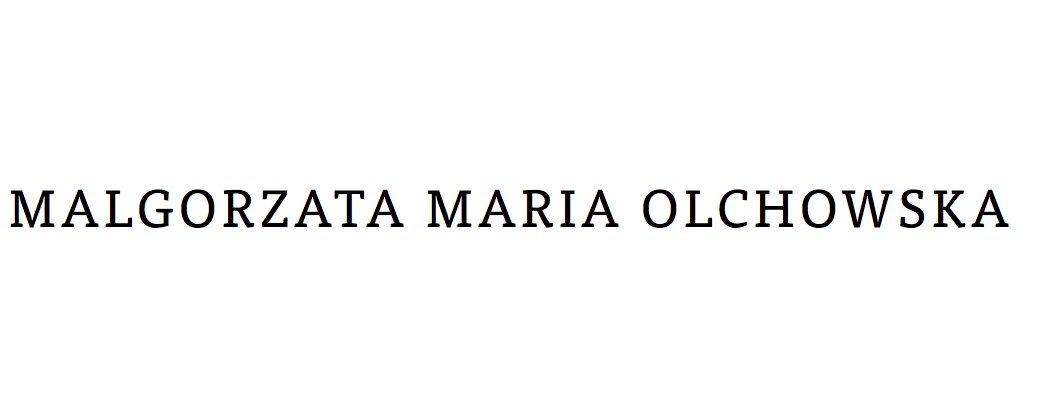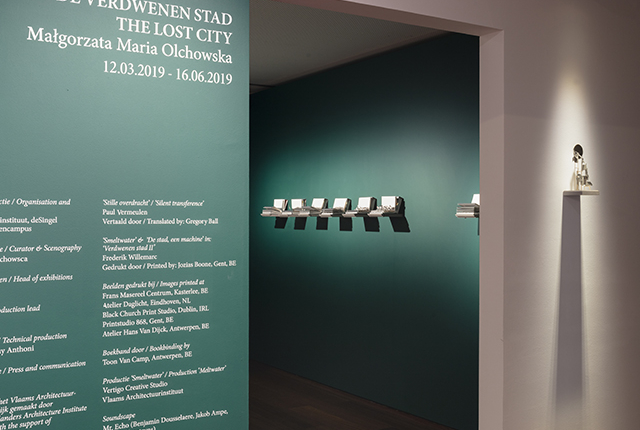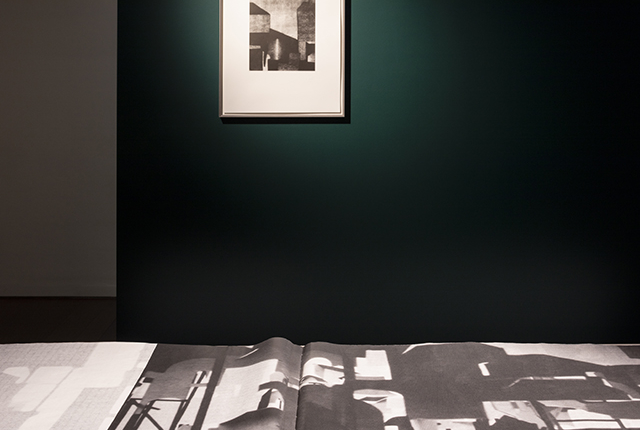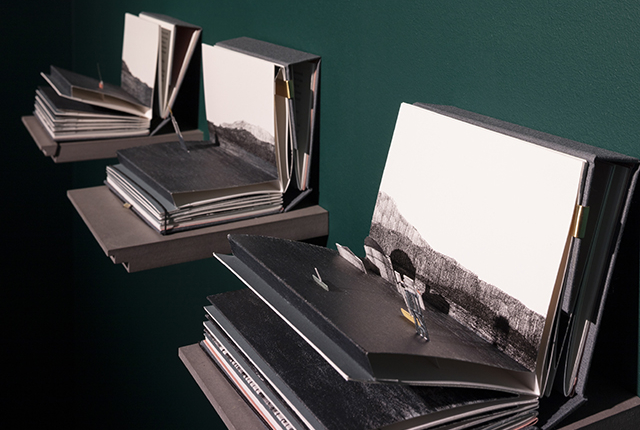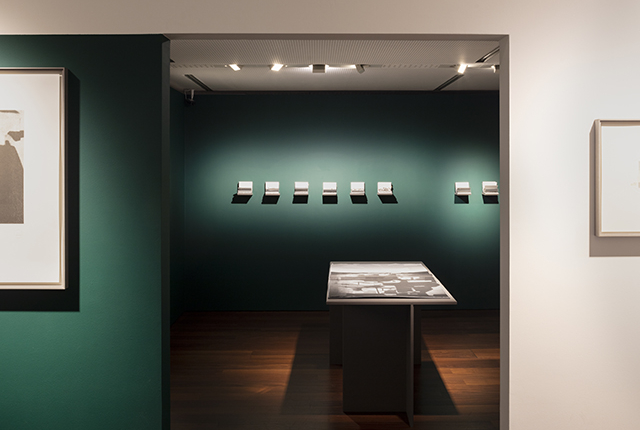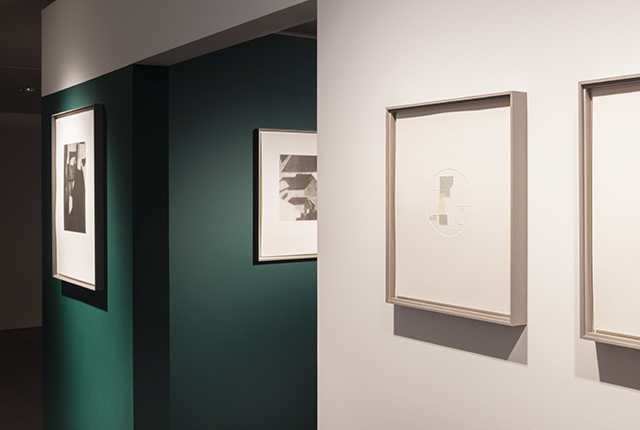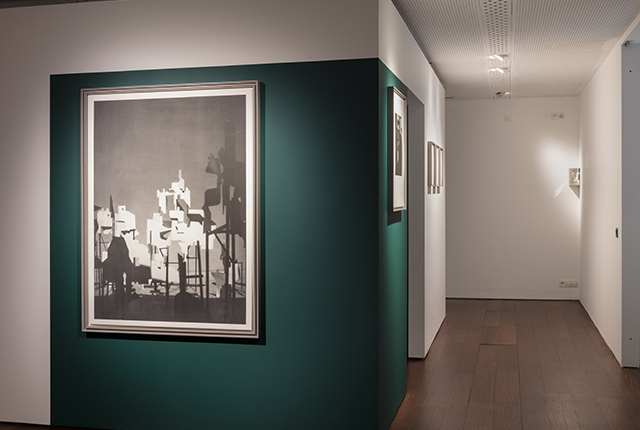Verdwenen stad _ exhibition
| 2019 | Flanders Architecture Institute | deSingel, Antwerpen |
photo’s Vlaams Architectuurinstituut © Michiel De Cleene
Silent transference
Let’s try to describe the vanished cities depicted by Gosia Olchowska. In most cases we see them from eye level, but on those few occasions when the viewpoint is higher, we see that the buildings and the in-between spaces form an irregular ground plan, where no efficient surveyor has stripped their approximate order of generous accident. Either the instruments of the grid could not yet be deployed, or else an approximation was considered sufficient, or regularity was impeded by the geographical or topographical conditions. Although there are monuments, the differences in scale are minor. The buildings are distinguishable, but are subject to a more or less similar unit size. A hill shifts a house up to the height of a tower. The colour of a window, the plane of a roof or a blank side-wall seasons and deepens the tone, but does not change it. A dome that does actually reach the horizon is no larger than a sun. The city is large enough not to be dominated by its monuments. We see more of the city through and behind the houses. It is a city to lose one’s way in; every through-view heralds a journey. The onion dome we noticed somewhere even indicates a location, though without committing itself, just as the round domes in a view of a city by Paul Klee must surely belong in a desert town.
Klee did not paint or draw rooms, but cities, laid out across the canvas, shuffling over the paper and made half visible under water. His cities live as if in a dream. He grasped the art of making the colours seem to fade, the planes seem smoky and the lines appear wounded, so that the portrait of the city, with no unnecessary details, shows the effect of time. It is said that he worked on three canvases simultaneously and occasionally added a brushstroke to each of them: to evoke time he accepted time. Olchowska does the same. An image is etched, then filled with ink and then printed on paper: this is the simplest process she allows. She prints coloured layers of paper into the blind stamping, she prints over the drawing that shows through the back, she builds just enough of the model to capture the space in a slow photo (using a camera obscura) which can then be laid over or under new layers in some way, in the darkroom or scanner. In this way she herself gives her cities a building history. Decay immerses her city in an appealing glow. Blank side walls can wait as long as they like for an adjoining building. The city remains ever unfinished. Nothing more than a nuance or an accent ever changes. So how can the city disappear?
In exactly the same way as it appeared. If we step backwards, eyes half closed against the everyday flashes, we see a broader tide. The city sinks into the coming flood, the world becomes dark and shapeless as it was before the age of the city. In the final image before the fall, piers appear beneath the buildings. Are they the high legs beneath Constant Nieuwenhuys’ New Babylon, the city that is escaping to a better place? (The field of grass pollen below Constant’s high legs looks like a desolate sea.) Or are they the piles beneath Amsterdam, where the ground is actually water that is so far still keeping the city afloat?
Bad dream or consolation? The ground in Olchowska’s images has been entirely watered down and washed away. Amongst the sheer foundation piles we discover a protected space: towering shelters with an outward view, enticing labyrinths under the crust of the city. Or is it just a void? Are we looking at a deserted city from which the inhabitants have been ousted? Such cities have existed, close to eastern fronts. It is not the cities but the borders that shuffled forward, to the beating of drums, and overtook the cities. Deserted cities filled up with new people who spoke a different language. With the eyes again half closed, it is not clear to see whether anything has changed or not. The buildings, with their stilt-like legs exposed or groin-deep in the mud, remain unmoved. They are the main characters, symbolically enlarged. It doesn’t matter who is behind the mask. The ground that has been washed away makes room for silence in every language, for emptiness, for air. As John Hejduk wrote in one of his notebooks: “I will tell you why I like the air I breathe, of course it keeps me alive, but there is a more important reason. It is because when I breathe the air in I breathe in all the sounds from all the voices since the beginning of time. All the voices that have placed thoughts into the air, that is, thoughts escaping from the soul through the voice into the air which I breathe in. Sounds that I cannot hear – silent sounds filling the air that generations have spoken into. Consequently filling me with words that are an invisible text. An invisible sound text which mingles with my thoughts that are invisible. In essence an internal communion takes place giving the sense of the sublimity of silent transference”.
– Paul Vermeulen –
